| Article ID | Journal | Published Year | Pages | File Type |
|---|---|---|---|---|
| 7610106 | Journal of Chromatography A | 2016 | 11 Pages |
Abstract
The method of making the new superficially porous particles is a process called pseudomorphic transformation (PMT), which is a form of micelle templating. Porosity is no longer controlled by randomly aggregated nanoparticles but rather by micelles that have an ordered liquid crystal structure. The new particle possesses many advantages such as a narrower particle size distribution, thinner porous layer with high surface area and, most importantly, highly ordered, non-tortuous pore channels oriented normal to the particle surface. This PMT process has been applied to make 1.8-5.1 μm SPPs with pore size controlled around 75 Ã
and surface area around 100Â m2/g. All particles with different sizes show the same unique pore structure with tunable pore size and shell thickness. The impact of the novel pore structure on the performance of these particles is characterized by measuring van Deemter curves and constructing kinetic plots. Reduced plate heights as low as 1.0 have been achieved on conventional LC instruments. This indicates higher efficiency of such particles compared to conventional totally porous and superficially porous particles.
Related Topics
Physical Sciences and Engineering
Chemistry
Analytical Chemistry
Authors
Ta-Chen Wei, Anne Mack, Wu Chen, Jia Liu, Monika Dittmann, Xiaoli Wang, William E. Barber,
